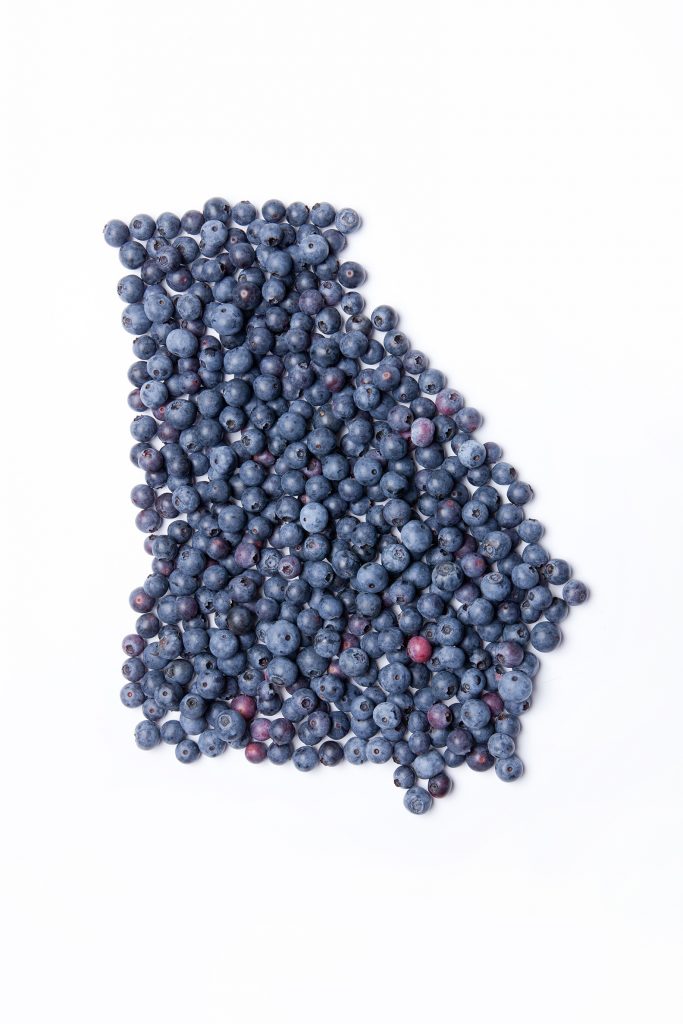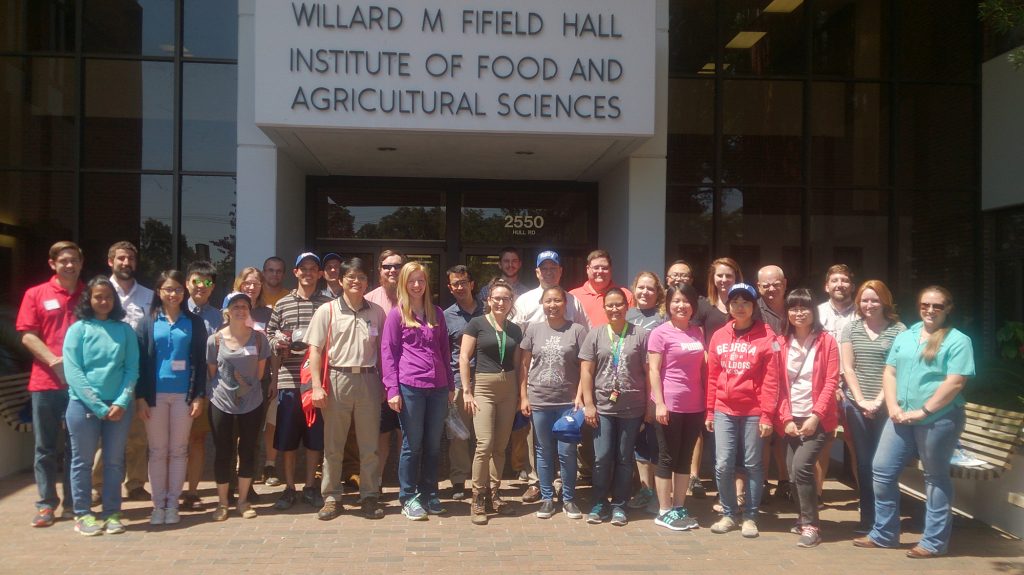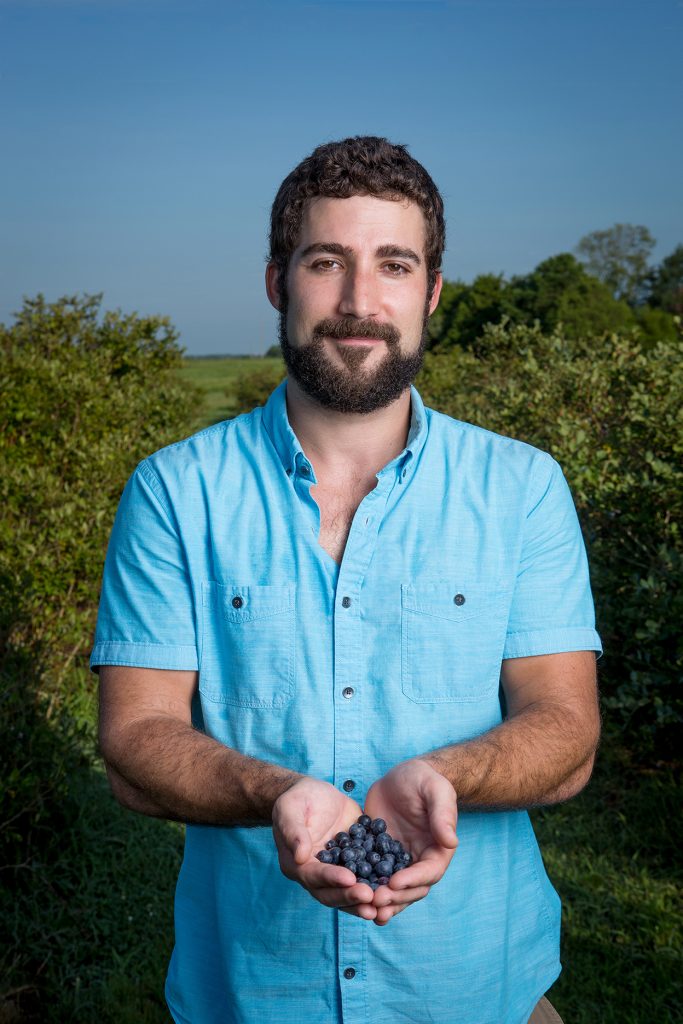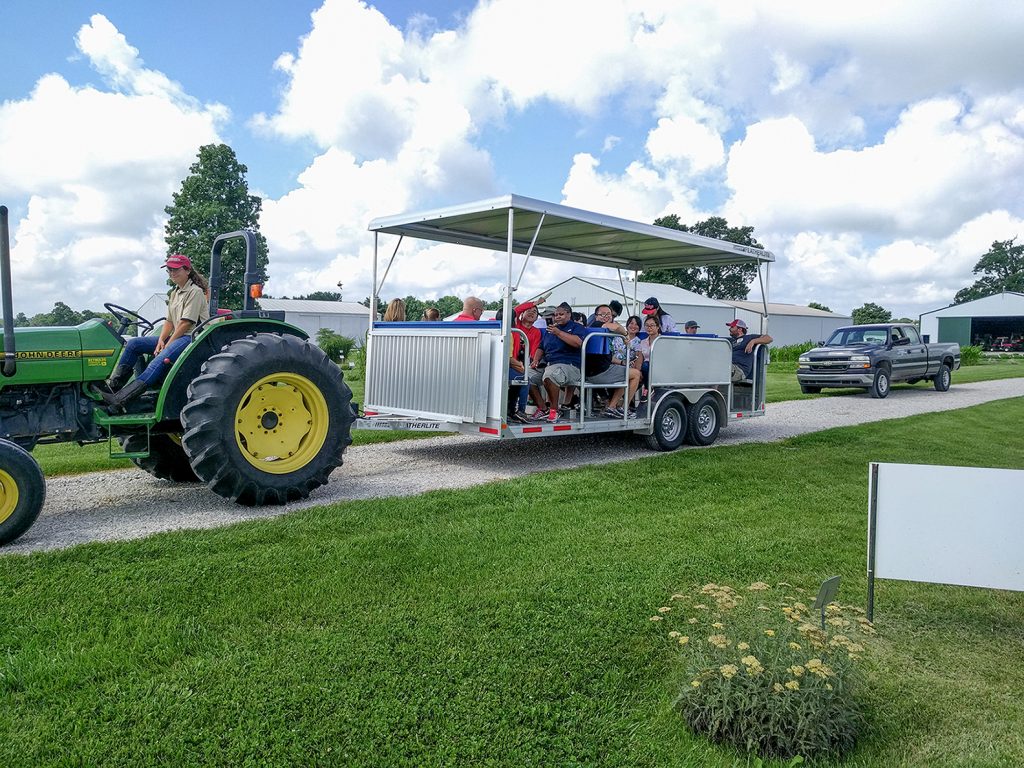Blueberry, the blue food: Call them a brain berry, call them profitable, or just call them plain delicious.
For a growing number of growers, the blueberry may be tiny but profits are huge. At UGA, researchers are helping demystify fungal diseases that ruin blueberry crops and impact yields.
By Cynthia Adams | Photos by Nancy Evelyn
For nearly 75 years, the University of Georgia has been at the forefront of the Georgia blueberry industry. UGA maintains a blueberry breeding program, and since 1944 the program has released 12 cultivars of the rabbiteye blueberry.
Although blueberries are grown in 38 states, Georgia is the leading producer among 10 states that account for the majority of all commercial production. These states include: California, Florida, Georgia, Indiana, Michigan, Mississippi, New Jersey, North Carolina, Oregon and Washington.
The blueberry, once called a “brain berry” by neuroscientist James Joseph, is known as a toothsome fruit offering important protection of the brain.
Unfortunately, the berry is vulnerable to both living and abiotic stress factors, which include water, temperature and sunlight. Fungal disease results in shriveled discolored fruit.
Historical Context
According to doctoral student Russell Ingram, “starting in 2008, Georgia growers began voicing concerns over an emerging disease that was causing reduced fruit quality, increased sorting costs in the packinghouses, and most importantly lower prices to grower’s due to downgraded fruit lots. Losses associated with this disease reached as high as complete rejection of fruit at the packinghouse and in isolated cases in Mississippi complete abandonment of commercial plantings.”
The emerging disease, Exobasidium, the cause of leaf and fruit spot of blueberries, says Ingram, “was found to be caused by the pathogen Exobasidium maculosum, and had previously been reported in North Carolina commercial plantings in 1998 by researchers at North Carolina State University. The reports at the time indicated that the disease occurred in the spring, causing light green spots on berries and leaves, but little to nothing was known of its disease cycle or risk factors for disease.”
Benefits of Blueberries and Brain Health
Blueberries are vitamin-rich berries that boost brain health via their high content of flavonoids. Berry fruits, like blueberries, can help the brain stay healthy via compounds that protect brain cells from free radicals. The antioxidants in blueberries can provide a real benefit in improving memory and cognitive function in older adults, and potentially prevent Alzheimer’s disease. medicaldaily.com
Value of Research in Fighting Disease
“The basis of what we do as plant pathologists is the development of control measures to reduce negative, disease-related impacts to our growers’ bottom line, says Ingram. “To do this scientifically almost always requires a basic understanding of the basic biology, or as we refer to it, the ‘disease cycle’ associated with
a plant pathogen on its host plant—in this case, blueberries. By understanding the disease cycle, we as researchers inform the development of disease control strategies that exploit aspects of the plant pathogen’s biology.”
Ingram’s Research: Where, What, and How?
“My research specifically focused on investigating the epidemiology of Exobasidium, leaf and fruit spot of blueberries,” Ingram adds. “This to a large extent meant that I was trying to answer questions such as, when does the disease occur, and how and when does it infect the plants?”
There are additional aspects to his research. “Where does the fungus that causes the disease spend the winter and from where does the disease spread the following year? What stages of the plant are susceptible to the disease? What environmental factors (temperature, humidity, sunlight) are necessary for disease development?”
Ingram says he and fellow researchers tracked these factors through subsequent growing seasons.
“From the research that I have conducted over the past four seasons, growers now know that the disease only infects young, tender leaves, berries, and stems; the disease is associated with extended periods of rain. The plant pathogen that causes the disease lives on the bark of the plant through the winter and spreads from there the following spring. The disease can be controlled by targeting the disease-causing spores of E. maculosum that live on the blueberry plant throughout the summer and winter months.”

Georgia now leads the nation in blueberry production.
Georgia has the longest growing season for blueberries lasting from late April through the end of July. Rabbiteye blueberries are native to Georgia and make up most of the commercial production.
Ingram explains how this information is helpful to breeders and why it is ultimately important. “Well, by bringing all of the pieces together, our research group has been able to develop science-based management recommendations, which, when applied properly can result in the almost complete eradication of the disease from our growers’ fields. In fact, after my presentation at a recent meeting in Savannah, Ga. this January, I had one grower say that by using our disease management recommendations he no longer has any issues with Exobasidium leaf and fruit spot of blueberries.”
None of this information came without serious wear-and-tear as Ingram logged many miles back and forth to research sites. “By the end of May this year, I will have driven 14,700 miles on the road for research. My research plot is 170 miles away in Alma, Ga., and from the end of February through May I drive down once a week,” the researcher says.
Sometimes, Ingram has unexpected company in the field.
“My work required me to take aerial samples at midnight each week. Which if you have never been in the middle of a blueberry field in the middle of nowhere in the middle of the night, it is a little spooky at times. Lots of little critters with glowing eyes are staring back at you from the darkness.”
When Ingram isn’t thinking of blueberries, he’s thinking of another wildly popular foodstuff: tea. He mentions a blight that affects tea with disastrous result.
“The other economically important disease caused by a pathogen closely related to ours is a disease called blister blight of tea. This disease is the single most important disease of tea.”
At one time, teas were grown in warmer regions of the United States and around Charleston, S.C. Currently, the largest tea plantation in the U.S. is in Charleston. The Charleston Tea Plantation’s teas were reintroduced there and are carried by commercial retailers and also sold on site.
The rapid expansion of the blueberry industry over the past 14 years
- Blueberry acreage in Ga. has almost quadrupled over this 14 year period.
Farm gate value has increased ten-fold.
- In 2014, Blueberries were the single most valuable fruit and nut crop in Ga.; second was pecans.
http://caes2.caes.uga.edu/center/caed/pubs/documents/2016CAEDFarmGateValueReport.pdf
“I plan on pursuing a position in the agrichemical industry within the area of product development. My interest in product development is mainly centered on the nature of the jobs. The positions in this area carry job titles such technical service representative or field scientist. and due to the applied nature of the associated research responsibilities I would get to keep one foot in the lab and one foot in the field,” says Ingram.
“One other way to stay in applied research I have explored is to pursue a career as an extension specialist. In addition to the applied focus of their research, extension specialists also have the privilege of serving their states by finding ways to save growers’ time and money. It is an extremely rewarding profession, but unfortunately, these positions are a bit harder to come by.”
Ingram isn’t discouraged. He later writes via email:
“At this point, I have learned about the positions available to me within industry and extension, per my skill set, and have also taken the extra steps to acquire the skills that I lacked to make myself a better candidate.
“I am now equipped with an education, a skill set, and a career focus. Given all that I have learned and experienced at UGA, I feel pretty good about my chances of success. But I also understand the need to remain flexible, because there are factors that will always remain outside of my control.”
Eager to Find Futures in Science Russell Ingram Creates a Map: Engaging 24 Fellow Graduate Students in Career Tour Taking Scientific Endeavor on the Road
Doctoral candidate Russell Ingram studies fungal pathogen on blueberries. Blueberries are a major Georgia crop, and diseased crops are a grower’s nightmare.
What impact might this have?
Consider this: Ingram’s blueberry research provides growers information on the disease cycle. Armed with this information, growers can better manage disease and protect their crops. The research may also mean significant savings for both growers and consumers—and improved production.
But Ingram is interested not only in blueberries, but in furthering his career options and helping fellow graduate students as well. Nearing the end of his studies last year, he applied considerable energies to SAPPs, UGA’s Student Association of Plant Pathologists.
In the summer of 2017, Ingram and his cohorts finalized the concept for an ambitious industry-focused Crop Protection Careers Tour. But that wasn’t all. The graduate students secured partners and found funding for industry exposures with leading crop protection companies. When done, SAPPs raised nearly $12,000 to pay for 24 graduate students’ travel and expenses.
The group also found a portal to future career opportunities.
Students in the College of Agricultural and Environmental Sciences, CAES, joined the inaugural tour, one culminating at Dow AgroSciences’s headquarters in Indianapolis. A grant the group secured from Dow AgroSciences’ Aid-to-Education Grant provided a portion of the funding.

Ingram with fellow UGA researchers and plant pathologists on their tour of potential employers last summer. Photo Credit: Russell Ingram
In the process, the students learned about professional opportunities, requirements, and corporate culture, all with an eye to furthering their own career preparations. Of necessity, they learned about grant writing and accounting, Ingram adds.
Ultimately, SAPPs recruited students from several departments, including entomology, plant pathology and weed science, in making the career tour happen.
“By including students from other departments, we broadened the appeal of the student visit to industry which encouraged much greater financial support and overall industry interest,” says Ingram.
“The single biggest logistical assistance came from Dana Nash (CAES academic affairs administrative manager.) She was, and is, an absolute amazing resource for all things accounting and student organization related within CAES. Associate Dean Joe Broder and Assistant Dean Jean Bertrand allowed Dana to help me with navigating university accounting policy and helped get me from getting myself into trouble.”
Ingram is soon to graduate, but the tour will go on. He has taken additional steps to make the tour an ongoing one. He has even organized a planning committee and allocated monies for this year to ensure that it will.
“I also secured $11,500 in funding and held $2,500 in reserve to help fund the 2018 tour. For this year’s tour, I have identified a fellow plant pathology graduate student, Amelia Lovelace, to take my place as program coordinator. I will also pick a team of student planners from this past year’s trip. To further institutionalize the program, special topics 8000 level course credit will be a course on the books.”
Mapping a Future
The initial idea for a career tour had originated with fellow students from plant pathology. The idea began quite simply. It was all about jobs. And it centered on the fact that there was a paucity of information.
Ingram helped identify and tap into a knowledge gap concerning private sector careers as he neared the end of his doctoral studies. “In my search for information on industry to prepare myself for a future job, I found that no one in my department (faculty or otherwise) could give me the information needed,”
he wrote.
Then Ingram sought out other students, asking if their frustrations were similar. He blogged. He used social media and every outlet at his disposal, including leveraging his position as student president of SAPPs.
They were.
Ingram found that like him, they shared “a desire to know more to prepare, but no structured means was available to them either.”
In Ingram’s mind, “This lack of understanding of industry, even in its basic function, was something that was a real problem for both students and the companies that wanted to hire them.”
Ingram and SAPPs networked, finding both students and companies motivated and willing to contribute to a career event they would take on the road. Both offered information, resources and logistical help. Many hours and contacts later, the career tour coalesced.
Contacts at Purdue University, developed through department alumna Kiersten Wise (now an extension specialist/associate professor at University of Kentucky) and Jean Bertrand (then assistant dean for CAES) connected Ingram with Dow AgroSciences.
Ingram operated the program with no faculty or staff. But he did get their affirmation. “Without the permission, trust, and support of the administrators this would have stayed a small departmental trip,” he adds.
“The biggest thing overall was knowing that I was permitted to do something of this nature.”











